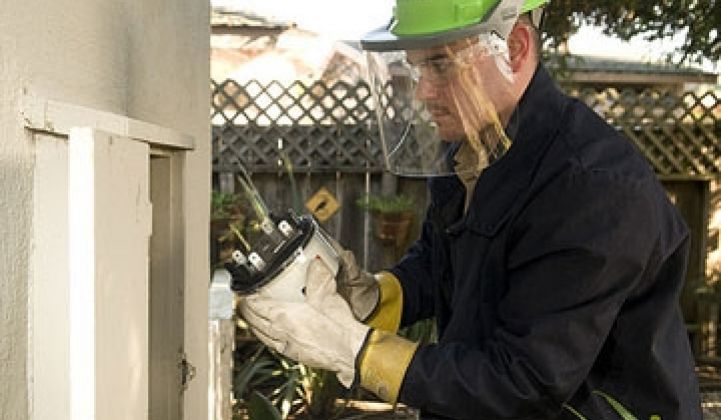San Francisco -- Pacific Gas & Electric CEO Peter Darbee spoke today at a public forum held at the California Public Utility Commission; naturally, the opponents of the smart grid and smart meters were there.
The PGE-vs.-(Some of )-The-People debate is the energy world's equivalent of Wrestlemania XVI -- you know the outcome and opinions, to some degree, in advance. And in true Wrestlemania spirit, some in the crowd hissed when the words "smart meter" were first uttered. When Darbee asked if the utility should be punished for innovating, someone murmured "Yes, yes!"
Still, it's good to keep track of the issue. Some of the highlights:
--More of the audience seemed far more worried about the alleged effects of electromagnetic radiation than about any supposed overcharging. Darbee, who came to PG&E from the telco industry, noted that the FCC, IEEE, EPA, FDA, OSHA and other organizations had studied the potential health effects with regard to cell phones and found no correlation. Cell phones, he added, expose consumers to greater amounts of radio waves. You hold cell phones to your ears and talk for minutes.
A smart meter is 20 or more feet away, transmits data for only around 45 seconds a day, and two or three walls usually sit between the consumer and the meter.
Nonetheless, PG&E performed some conservative calculations on exposure. The utility assumed consumers would sit ten feet from their meter and no intervening walls existed. It found that cell phones expose consumers to 13,000 times as much EMF.
--One of the principle causes of the Bakersfield problem, where consumers found that their power bills jumped and blamed it on smart meters, turns out to be how PG&E has to charge for power. Californians pay for power according to five rate tiers. Power bought under Tier 1 and 2 costs around 10 cents a kilowatt hour. When you exhaust your Tiers 1 and 2 kilowatt hours, you start to pay under the rates set forth in Tiers 3, 4, and 5.
In 2001, the state froze Tier 1 and 2 pricing. All rate increases since then have been imposed on Tiers 3, 4 and 5. (Last fall, California ruled that Tier 1 and 2 rates can now float upward.)
As a result, Tiers 3 through 5 have risen to 30, 40 and 50 cents a kilowatt hour, respectively. Last year, summer was extraordinarily brutal in Bakersfield. In July, the city experienced 17 days with recorded temperatures in excess of 100 degrees. Only six occurred the year before. Under its own modeling, the air conditioning load to accommodate the extra cooling needed could raise a person's utility bill from $200 to $800.
"I don't think people understood the tiered system," he said. "I think the rate structure was the primary driver."
PG&E also did a terrible job in communicating the benefit of the meters. It also should have left control analog meters in place -- i.e., have two meters at one house -- to show that they work the same way and are equally accurate. Ninety-nine-percent-plus of the meters are accurate, he said. One more note: many of the meters were in place a year before the complaints started.
--Nuclear? PG&E remains neutral on the issue. The state and the people want to concentrate on efficiency and renewables first, so that is what the company will do. Speaking of efficiency, the utility and the state have to figure out ways to value these programs better so Wall Street will follow suit. Utilities are not rewarded for efficiency programs, even in de-coupled states like California.
--Obama made a crucial mistake when he put immigration ahead of energy on his legislative agenda, Darbee said. Republican senator Lindsay Graham had agreed to join the fight for an energy bill. Fellow Republicans attacked Graham. But when Obama shifted gears, Graham interpreted that as a broken promise and balked.
--Bureaucracy in California remains stressful and onerous. It takes about seven years to nine years to get a large-scale renewable project off the ground, he said.
"The greatest obstacles we face in bringing more renewables to market are the difficulties in permitting and agency approvals at the local, state and federal levels," he said. (See Brett Prior's article today about the colonoscopy that solar thermal companies have to endure for permitting and some of the proposed solutions.)
--Why did PG&E fund Proposition 16, which would have made it tough for cities to set up utilities? PG&E had already spent $24 million to $30 million fighting eminent domain actions in Sacramento and San Francisco that, if successful, would have meant giving utility assets to those counties.
"$45 million (for Prop 16) versus $15 million a year. Financially, it made sense," he said.
--Years ago, Darbee established a household efficiency program that worked. He charged his kid 25 cents per energy-wasting incident, e.g., leaving the lights on. It worked.



